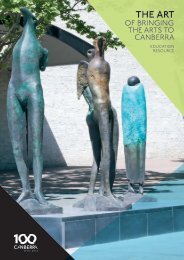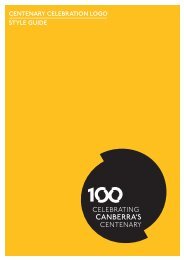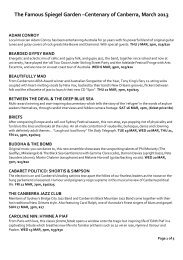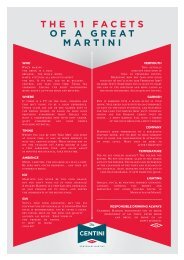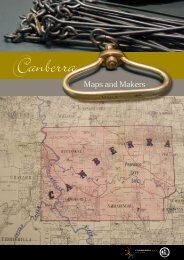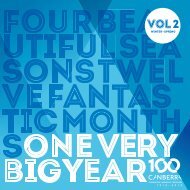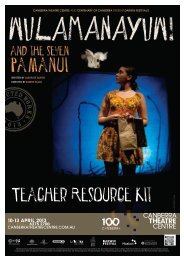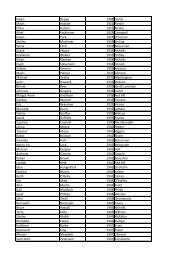Volume One - Pages 77 to 108 - Canberra 100
Volume One - Pages 77 to 108 - Canberra 100
Volume One - Pages 77 to 108 - Canberra 100
Create successful ePaper yourself
Turn your PDF publications into a flip-book with our unique Google optimized e-Paper software.
TOUCH: Sculpture and the Land<br />
THROUGHOUT MAY<br />
10 MAY (KEYNOTE AND BIG ISSUES/BIG TALK LECTURE)<br />
10 – 12 MAY SYMPOSIUM<br />
<strong>Canberra</strong>’s public sculptures are a national highlight. Sculpture in all its forms plays a<br />
prominent part in <strong>Canberra</strong>’s cultural landscape. Sculpture collections, site specific<br />
commissions, sculpture gardens and parks, public and private collections are a source of<br />
community pride, occasional controversy, and an attraction for <strong>to</strong>urists.<br />
The TOUCH: Sculpture and the Land program celebrates <strong>Canberra</strong>’s public sculpture and<br />
the people involved. The project canvasses the conversations and ideas around some of the<br />
issues associated with sculpture commissions. The National Gallery of Australia and local<br />
visual arts organisations—Australian National University (ANU) School of Art, ANU Drill Hall<br />
Gallery, <strong>Canberra</strong> Museum and Gallery (CMAG), <strong>Canberra</strong> Glassworks and the Strathnairn<br />
Art Centre are involved. Their events present a variety of approaches <strong>to</strong> sculpture with<br />
visiting artists-in-residence, exhibitions, new commissions, walks, talks and <strong>to</strong>urs of existing<br />
collections. Ac<strong>to</strong>n Walkways will encourage people <strong>to</strong> see themselves in new spaces and is<br />
organising scenic sculpture walks linking the city <strong>to</strong> the lake via the ANU Campus, NewAc<strong>to</strong>n<br />
and <strong>Canberra</strong>’s Street Arts Trail. A high-profile event for TOUCH is an International<br />
Symposium at the National Gallery of Australia.<br />
Building on the theme SCULPTURE: Space and Place, the symposium will present national<br />
and international perspectives as a context for discussion about sculpture in <strong>Canberra</strong>. Held<br />
10-12 May, with keynote by Vivien Lovell, sculpture and public art in all its forms will be<br />
discussed.<br />
Since its inception, <strong>Canberra</strong> has established an impressive record of commissioning public<br />
sculpture. Associated with the Australian War Memorial (AWM) in the 1930s, came the<br />
decision <strong>to</strong> develop ANZAC Parade with its series of large-scale commissioned sculptures<br />
commemorating major theatres of war and the subsequent development of a Sculpture Park<br />
adjacent <strong>to</strong> the AWM. In the 1950s, the ANU established a policy <strong>to</strong> develop an integrated<br />
environment in which architecture, landscape design and sculpture all complement each<br />
other. This involved the incorporation of commissioned art works as part of campus building<br />
developments with the first sculpture, Gerald Lewers’ ‘Reclining Figure’ 1953 at the entrance<br />
<strong>to</strong> University House. Today, the ANU collection includes 60 site specific sculptures. Since<br />
2001, the campus also boasts an International Sculpture Park embracing the Old <strong>Canberra</strong><br />
House precinct, extending across grassy slopes and open woodlands <strong>to</strong> the shores of Lake<br />
Burley Griffin.<br />
In 1958 the National Capital Development Commission (NCDC) was set up, and a program<br />
<strong>to</strong> provide works of art as an integral part of its building and urban development plans was<br />
established. The first NCDC commission for a work in a public place was given <strong>to</strong> Tom Bass<br />
in 1959 for the statue of ‘Ethos’ in Civic Square. The policy of associating works of art with<br />
the construction of new buildings continued until 1988, when the new ACT Government<br />
continued this approach. It established the ACT Public Art Policy, resulting in an impressive<br />
Street Arts Trail.<br />
The establishment, in 1975, of the <strong>Canberra</strong> School of Art (now ANU School of Art) with its<br />
Sculpture Workshop and visiting sculp<strong>to</strong>rs-in-residence, added profile <strong>to</strong> sculpture energy<br />
and activity in <strong>Canberra</strong>. In 1982, an important landmark was the opening of the National<br />
Gallery of Australia (NGA) and its Sculpture Garden, presenting significant sculptures in an<br />
Australian bushland setting. In 1988, the opening of the new Parliament House showcased<br />
art and sculpture collections in and around the extensive buildings and grounds. Opened<br />
in 2010, the recent extension <strong>to</strong> the NGA has continued its policy <strong>to</strong> focus on sculpture<br />
with a new garden setting. The James Turrell SkySpace commission is a major attraction.<br />
Since 2000, the private sec<strong>to</strong>r has become very involved, with <strong>Canberra</strong> CBD, NewAc<strong>to</strong>n,<br />
ActewAGL and <strong>Canberra</strong> Airport all active in commissioning impressive sculptural works as<br />
part of their developments and enhancement of the city.<br />
The TOUCH: Sculpture and the Land program celebrates <strong>Canberra</strong>’s national reputation as a<br />
City of Sculpture.<br />
Image: Commissioned by Actew AGL in 2010 <strong>to</strong> celebrate its 10 th anniversary. ‘The Journey’ by Robert Foster.<br />
WWW.NGA.GOV.AU AND WWW.CANBERRA<strong>100</strong>.COM.AU<br />
92<br />
CANBERRA<strong>100</strong>.COM.AU



